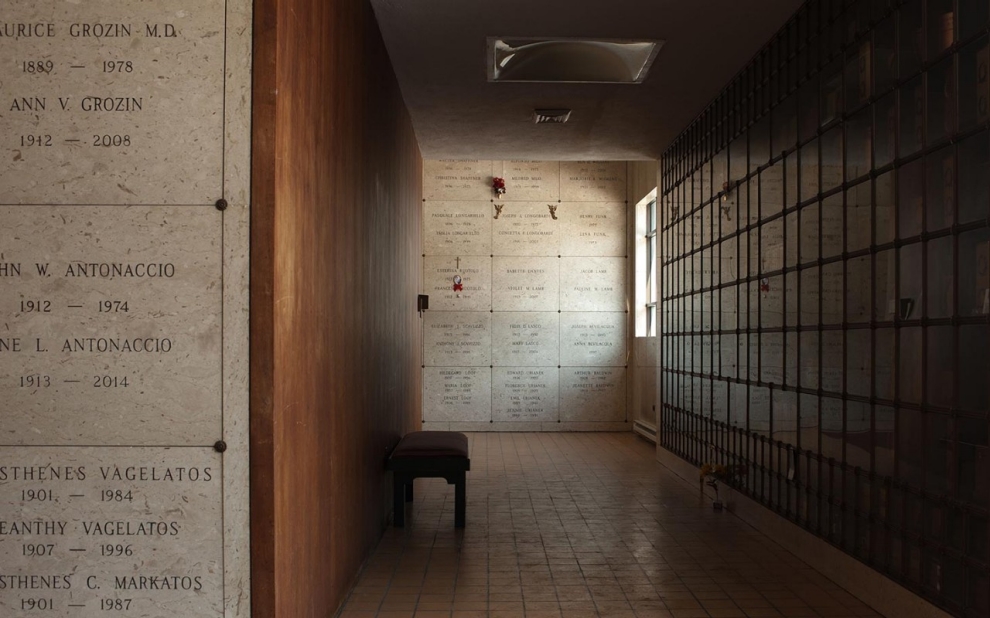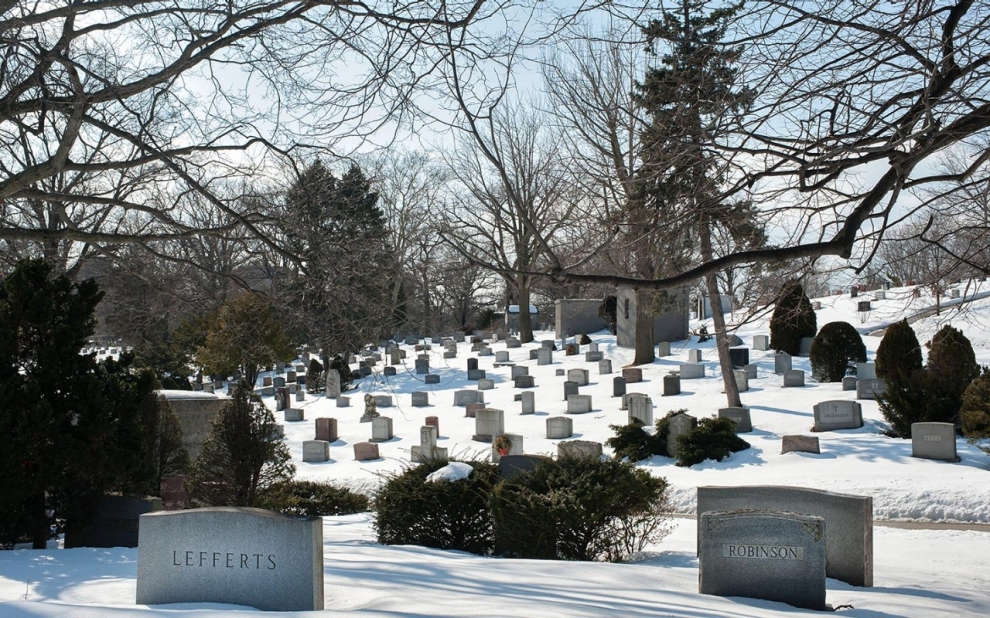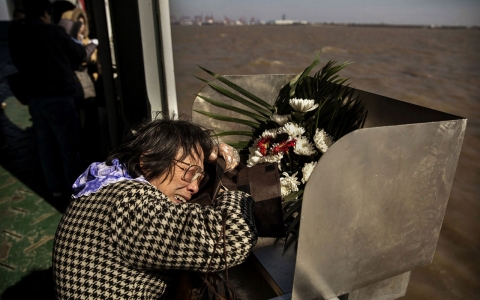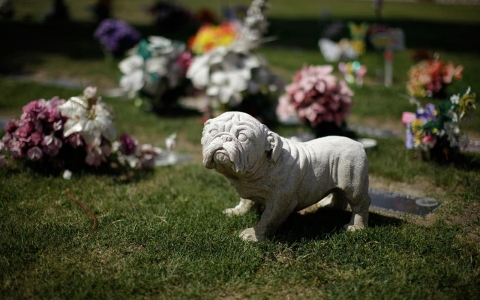U.S. cemeteries are banking on the country’s growing cremation rate — projected to overtake that of casketed burials for this first time this year — to keep them open and accepting remains for as long as possible. In their remaining acreage and patches of grass, cemeteries are finding places that might not fit a coffin but could fit several urns.
In urban areas, like Manhattan and Washington, D.C., cemetery expansion isn’t just expensive; it’s often impossible. But cremation’s increasing popularity is delaying these cemeteries’ inevitable closure. In just over half a century, nationwide cremation rates have increased 12-fold, skyrocketing from 3.6 percent in 1960 to 45.3 percent in 2013, according to an annual report from the Cremation Association of North America (CANA).
Cremation, which is generally less expensive than in-ground burial, increased during the recession more than expected, according to the association’s executive director Barbara Kemmis. From 1997 to 2002 and from 2002 to 2007, the cremation rate increased 5.1 percent and 6.0 percent, respectively. From 2007 to 2012, which included the recession, cremation increased 9.3 percent.
That increase was greater in states hit particularly hard by the recession, like Michigan, which saw the percentage of cremations increase from 40.5 percent in 2007 to 49.1 percent in 2011 alone. This year the U.S. cremation rate is projected to overtake that of casketed burials for this first time, according to the National Funeral Directors Association (NFDA), and by 2030 the cremation rate is projected to be 70 percent.
The cost of cremation and burial have risen at about the same rate. In 2004 the median burial cost $1,650, and immediate cremation cost $1,495, according to the NFDA. In 2012 burial cost $2,890, and immediate cremation cost $2,245.
Those figures don’t include the extras, like a casket, which starts at about $2,000, or an urn, which usually costs less than $300, according to the NFDA. Cremation costs cover removal and storage of the deceased, cremation and the return of cremated remains. Viewing the body and memorial services and special vaults cost more.
The baby boomer generation — which includes Vietnam War vets — and U.S. engagement in two wars has put pressure on Arlington National Cemetery, the U.S. military cemetery in Virginia. In response to estimates that by the early 2020s the cemetery will run out of space, Arlington announced in 2013 an expansion project to develop its last tract of land, with a special emphasis on cremation niches.
Over the next two years, the expansion will add 27,282 new gravesites — 60 percent of which will be dedicated to cremated remains. With limited space to expand, Arlington is concerned with making the most effective use of the space it has available. Today more than 400,000 service members, veterans and their family members are interred at Arlington, 27 percent of whose remains are in a columbarium, or niche wall.

“Our main focus is extending the life of the cemetery as long as possible,” said Jennifer Lynch, a spokeswoman for Arlington. The cemetery estimates it will remain open for first interments — the burial of the first eligible family member — through the 2050s.
In the 1960s, out of a growing concern for space, the federal government tightened requirements for in-ground burial at Arlington; its guidelines are the most stringent of any national cemetery. But requirements for aboveground inurnment of cremated remains are less strict, which likely contributes to the its exceptionally high cremation rate.
Most members of the armed forces who served at least one day of active duty (in addition to training) and received an honorable discharge are eligible for aboveground inurnment at Arlington. But eligibility rules for burial are myriad; examples of people who qualify for inurnment but not burial include military personnel who were U.S. citizens but served in a foreign allied army during a period of military engagement, and members of a reserve component of the armed forces who died during active duty.
David Ison, the director of sales and marketing at Woodlawn Cemetery in Bronx in New York, has been in the death and deposition business for 25 years. He said that one of the most influential holdouts against cremation has been the Catholic Church.
The church’s restrictions against cremation date to the late 1880s and were a response to the pro-cremation movement, which trumpeted the environmental and aesthetic virtues of cremation over burial. Those leading the pro-cremation movement also happened to be vocally opposed to the Catholic Church — leading the church to see choosing cremation as an anti-religious statement.
When Pope Paul VI lifted the ban in 1963, he said that people who chose to be cremated would no longer be denied the sacraments.
Americans’ increased mobility has also contributed to cremation’s increasing popularity over the last 50 years. Many people leave home for college, then move, sometimes multiple times, for work or family, and some relocate again in retirement — and it’s much easier to move ashes than a coffin.
New England and the West have the highest percentage of cremations in the United States. Nevada has the highest cremation rate in the nation, at 74.2 percent, according to CANA. Oregon, Hawaii and Arizona are among the top 10.
Kemmis attributed the increased acceptance of cremation in Western states, Florida and northern New England to the higher cost of space and less cultural attachment to traditional casketed burial. The South, on the other hand, has the country’s lowest cremation rates.

"We’re a very transient nation, and that level of transience is less prevalent in Southern states,” Kemmis said. "People are more tied for all sorts of reasons to their small towns.”
About one-third of people who chose cremation made arrangements to have their remains placed in a columbarium at a cemetery or crematory or buried, according to CANA research from 2006.
Despite cremation’s increasing popularity, Ison was adamant that a physical memorialization of a loved one is and remains a crucial step in the grieving process. “Scattering of cremated remains is really romanced in movies,” he said, but “if you want to come visit your dad or your mom, if you pour them into the ocean, you don’t have a place to visit.”
Joseph Di Troia, who has worked at Fresh Pond Crematory in Queens in New York since 1967, agreed. If you’re thinking of scattering the ashes right after your loved one’s death, just wait, he says. Death can make you do things you may later regret.
The crematory where he works does not include a cemetery with burial plots. At Fresh Pond, all remains are housed in niches in two large buildings. Unlike cemeteries, where directors think in developed and undeveloped parcels of land, Troia thinks in terms of hallway space. “Acres? I’m not used to thinking in acres of land. We have 16,000 niches. We have 40,000 cremated remains [or] over,” he said.
“You need a big ladder to go in some of the niches that we have,” he said. “Niches today, they don’t take much room.”
He doesn’t think the building, which was built when the crematory was established in 1884, will fill up in his lifetime, but if it does, there’s room for another building on Fresh Pond’s land.
Di Troia sees it as Fresh Pond’s mission to explain all the options available to anyone considering cremation. He is emphatic that cremation isn’t impersonal and that, just like burial, cremation services are customizable: You can have a wake with the body present. After cremation, you can take the remains home, or you can buy a niche where they will be housed. There are bronze-front niches, glass-front niches and family niches too.
“You could do a baseball urn, a Yankee urn, [even] a Kiss urn,” he added.

FTC considers SCI's acquisition of second-largest funeral home chain while concerns rise over its increasing dominance

With decreasing space for graves on land, the country of 1.3 billion is offering money to encourage sea burials

Want end-of-life services for your animal companion? If you’ve seen it for a human, you can get it for a pet





Error
Sorry, your comment was not saved due to a technical problem. Please try again later or using a different browser.